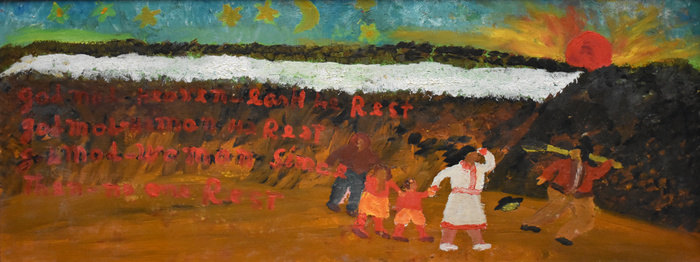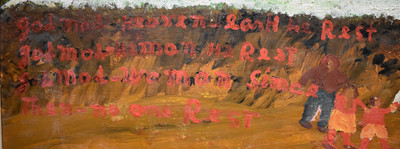Johnnie Swearingen "God Made Heaven" 2
-
- Johnnie Swearingen
- (1908-1993)
- Brenham Artist
- Image Size: 11.5 x 29.5
- Frame Size: 12.5 x 30.5
- Medium: Oil
- Unsigned
- "God Made Heaven" 2
- Contact for Price & Info
- View All By This Artist
Details
Religious, Scripture, Figures
Black Folk Art -
-
Biography
Johnnie Swearingen (1908-1993)
The following was compiled and written by Perryman Collins:
Reverend Johnnie Swearingen was born August 27, 1908 in a rural African American community outside of Chappell Hill, in Washington County, Texas
He died January 14, 1993 in Brenham, Texas
He painted at his home in Brenham, Texas
He is best known for his often colorful primitive oil paintings of rural Texas landscape encompassing the people who lived and worked there.
His style of work can best be described as primitive realism.
Worked early on with just about any pigmented material he could find. Later, he was to work entirely in oil paint.
His work is in the permanent public collections of:
Museum of American Art, Smithsonian Institute, Washington, D.C.
The Menil Collection, Houston, TX
New Orleans Museum of Art, New Orleans, LA
Museum of Southeast Texas, Beaumont, TX
Blanton Museum of Art, Austin,TX (formerly Huntington Museum)
Chappell Hill Historical Society, Chappell Hill, TX
African American Museum, Dallas, TX
Exhibitions 1995-1999:
1999 "Black Texas Folk Artists", African American Museum, Dallas,TX
1998 "Spirited Journeys--Self-Taught Texas Artists of the Twentieth-Century", Huntington Art Gallery, University of Texas, Austin, TX Curated by Lynne Adele (traveling exhibition and catalog).
"Folk Art From the Menil Collection" the Menil Collection, Houston, TX, Curated by Paul Winkler
"I Make Pictures" The Masterful Paintings of Reverend Johnnie S. Swearingen, African American Museum, Dallas, TX (traveling to Intuit in Chicago)
"Reverend Johnnie S. Swearingen" from the collection of The Chappell Hill Historical Association Yard Dog Gallery, Austin, TX
1997 "Texas Folk Art" (catalog) Sam Houston State University, Huntsville, TX, Curated by Stephanie Smither
1996 "Wind in My Hair" National Museum of Visionary Art, Baltimore, MD, Curated by Susanne Theis
1995 "Tree of Life (catalog) National Museum of Visionary Art, Baltimore, MD, Curated by Roger Manley
"Pictured in My Mind" Contemporary American Self-Taught Art from the Collection of Dr.Kurt Gitter and Alice Rae Yelen Birmingham Museum of Art, Alabama (catalog)
Born into a sharecropper's family and always associated with the land and rural people, he became firmly attached to them and they were to become the foundation of his art . Little is known about his early years but one can only surmise, when viewing his paintings, that he worked with his family in the fields. At some point in time he became known for his sermonizing and later completed a correspondence course at a Bible school. He then became an ordained minister but had no church and continued to work the soil.
Following a failed marriage and the loss of an infant child in 1926, he moved to California where he worked as a longshoreman. While there in 1948, he received word that his father was ill. He returned to Texas and resumed farming and began painting and preaching in and around Brenham. Although he had received Bible school corresdence courses, he had no training in any form of art. He was completely self -taught in art.
He began painting on any material he could find and using any pigmented substance. Many of his early paintings were on cardboard from boxes, tin, tar paper,and any other substance that could be used as surface material. Sometime the material he used for paint would literally take years to dry, if ever. In time he was to settle on oil paint and masonite. Many of his masonite paintings have a hole in the mid upper surface where he had affixed the blank piece of masonite to a tree or some other hard substance in order to paint on it. He began selling his paintings in various locations from his truck and from a roadside stand in front of his house. He obtained an easel and was then able to eliminate the nail hole. People began bringing stretched canvasses to him and most of his later paintings were on canvas. He signed most of his paintings with a characteristic black JSS or occasionally Rev JSS.
His work was first formally exhibited in 1980 in Eyes of Texas: An Exhibition of Living Texas Folk Artists, University of Houston. He continued to paint up until he died in 1993.





